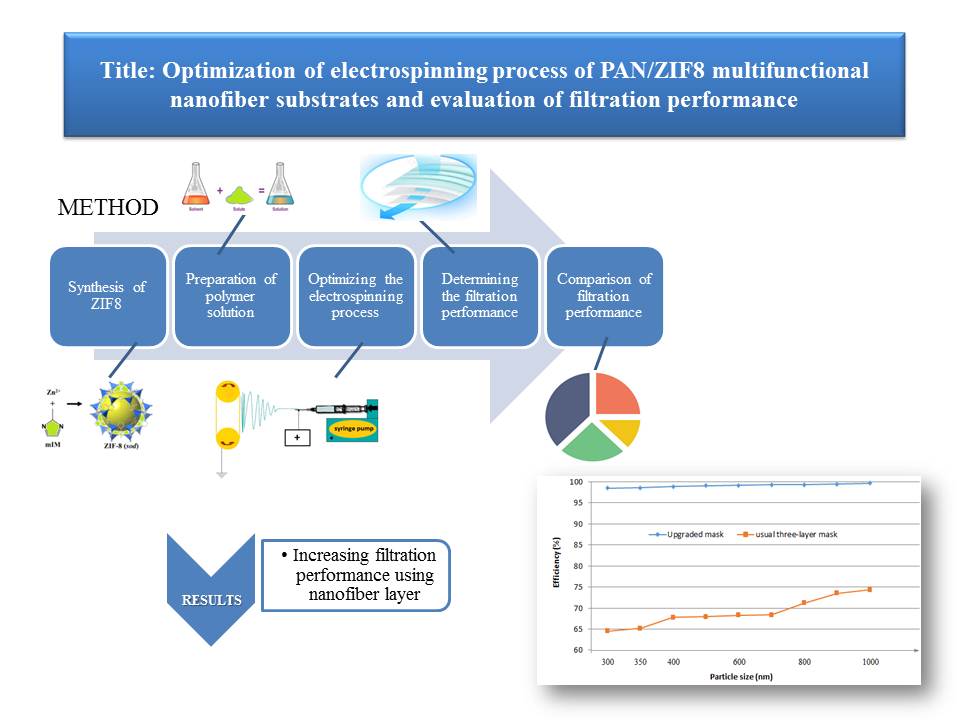Volume 13, Issue 2 (6-2023)
J Health Saf Work 2023, 13(2): 384-403 |
Back to browse issues page
Download citation:
BibTeX | RIS | EndNote | Medlars | ProCite | Reference Manager | RefWorks
Send citation to:



BibTeX | RIS | EndNote | Medlars | ProCite | Reference Manager | RefWorks
Send citation to:
Jafari A, Ghorbani Shahna F, Bahrami A, Habibi Mohraz M. Optimizing the Electrospinning Process of PAN/ZIF8 Multifunctional Nanofiber Substrates and Using Them in Respiratory Protection Masks. J Health Saf Work 2023; 13 (2) :384-403
URL: http://jhsw.tums.ac.ir/article-1-6848-en.html
URL: http://jhsw.tums.ac.ir/article-1-6848-en.html
1- Center of Excellence for Occupational Health Engineering, Occupational Health and safety Research Center, School of Public Health, Hamadan University of Medical Sciences, Hamadan, Iran
2- Center of Excellence for Occupational Health Engineering, Occupational Health and safety Research Center, School of Public Health, Hamadan University of Medical Sciences, Hamadan, Iran ,m.habibi@umsha.ac.ir
2- Center of Excellence for Occupational Health Engineering, Occupational Health and safety Research Center, School of Public Health, Hamadan University of Medical Sciences, Hamadan, Iran ,
Abstract: (985 Views)
Introduction: With the spread of the COVID-19 pandemic and the lack of adequate protection by existing protective equipment, many researchers’ attention has turned to developing improved respiratory protection equipment. Considering their special properties and nanoscale dimensions, electrospun nanofibers are a suitable option for improving operational characteristics of substrates used in conventional facemasks. This study aimed to optimize the electrospinning process of polyacrylonitrile nanofibers (PAN) containing ZIF8 and use the optimized substrate in medical facemasks to increase their protective performance.
Material and Methods: This study employed an environmentally friendly method to synthesize ZIF8 in an aqueous environment. Then, PAN/ZIF8 polymer solutions were prepared in dimethylformamide. The effects of electrospinning parameters, including electrospinning voltage, polymer solution concentration, electrospinning distance, and polymer injection flow rate on diameter and uniformity of nanofibers were investigated. Electrospinning conditions were optimized using response surface methodology (RSM) and central composite design (CCD) to obtain desired values for response (dependent) variables. Finally, optimized PAN/ZIF8 and PAN nanofibers were electrospun on spun-bond substrate. Base weight, average diameter of fibers, filtration performance, pressure drop, and quality factor of fabricated substrates were assessed.
Results: According to results, optimal conditions for electrospinning of PAN/ZIF8 polymeric solution for polymer concentration (A), electrospinning voltage (B), electrospinning distance (C), and polymer injection flow rate (D) were respectively 70 w/v%, 20 kV, 18 cm, and 0.4 ml/h. Moreover, despite lower base weight of PAN/ZIF8 nanofiber mask, it displayed higher filtration performance (98.51%), lower pressure drop (31.42 Pa), and higher quality factor (0.140 Pa-1) in comparison to other studied masks.
Conclusion: Experimental models developed in this study provide acceptable values for filtration efficiency and quality factor for filtration applications. Additionally, they serve as a guideline for subsequent experiments to produce uniform and continuous nanofibers with desired diameter for future applications in absorbent media (intermediate absorbent layers) of respirators.
Material and Methods: This study employed an environmentally friendly method to synthesize ZIF8 in an aqueous environment. Then, PAN/ZIF8 polymer solutions were prepared in dimethylformamide. The effects of electrospinning parameters, including electrospinning voltage, polymer solution concentration, electrospinning distance, and polymer injection flow rate on diameter and uniformity of nanofibers were investigated. Electrospinning conditions were optimized using response surface methodology (RSM) and central composite design (CCD) to obtain desired values for response (dependent) variables. Finally, optimized PAN/ZIF8 and PAN nanofibers were electrospun on spun-bond substrate. Base weight, average diameter of fibers, filtration performance, pressure drop, and quality factor of fabricated substrates were assessed.
Results: According to results, optimal conditions for electrospinning of PAN/ZIF8 polymeric solution for polymer concentration (A), electrospinning voltage (B), electrospinning distance (C), and polymer injection flow rate (D) were respectively 70 w/v%, 20 kV, 18 cm, and 0.4 ml/h. Moreover, despite lower base weight of PAN/ZIF8 nanofiber mask, it displayed higher filtration performance (98.51%), lower pressure drop (31.42 Pa), and higher quality factor (0.140 Pa-1) in comparison to other studied masks.
Conclusion: Experimental models developed in this study provide acceptable values for filtration efficiency and quality factor for filtration applications. Additionally, they serve as a guideline for subsequent experiments to produce uniform and continuous nanofibers with desired diameter for future applications in absorbent media (intermediate absorbent layers) of respirators.
Type of Study: Research |
Received: 2023/06/29 | Accepted: 2023/06/22 | Published: 2023/06/22
Received: 2023/06/29 | Accepted: 2023/06/22 | Published: 2023/06/22
Send email to the article author
| Rights and permissions | |
 |
This work is licensed under a Creative Commons Attribution-NonCommercial 4.0 International License. |







